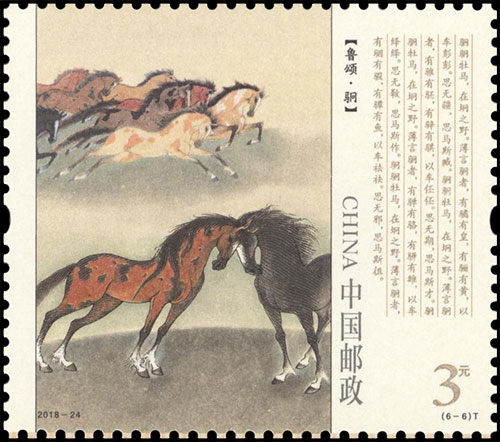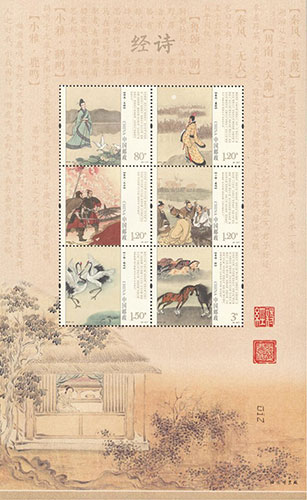
China Post issued a set of special stamps themed on the Chinese classic Book of Songs on September 8, 2018
The Classic of Poetry is the first collection of Chinese poetry, comprising 305 works dating back from the Western Zhou period to the middle of the Spring and Autumn period (about 11th to 7th centuries B.C.). The content of the poetry can be divided into two main sections: the “Airs of the States” and the hymns and eulogies.
 There are 160 odes in total relating to 15 states, 105 hymns comprised of "Lesser Court Hymns" and "Major Court Hymns," as well as 40 eulogies, among them the "Eulogies of Zhou", "Eulogies of Lu" and "Eulogies of Shang".
There are 160 odes in total relating to 15 states, 105 hymns comprised of "Lesser Court Hymns" and "Major Court Hymns," as well as 40 eulogies, among them the "Eulogies of Zhou", "Eulogies of Lu" and "Eulogies of Shang".
The Classic of Poetry is the first belles-lettres monograph in China, and ushered in the era of narration and lyricism in Chinese poetry. Therefore, it is called the “ancestor of belles-lettres.”
It determines the rhetoric principle and rhyming principle of Chinese poetry, and is called the “ancestor of collections” and the “ancestor of poetry.”
The Classic of Poetry shows a passion for social reality, a strong sense of politics, morality, and a sincere and positive attitude towards life, which is summed up by later generations as an elegant spirit. It has directly affected the creation of later poetry, and is a highlight of realistic Chinese literature.
The Classic of Poetry occupies an important position in the history of Chinese and world culture with its rich content, great ideological and artistic achievements, and has had an indelible impact on later literature.
This set of stamps uses traditional Chinese painting techniques and features an artistic rendition of the artistic conception of poetry.
The last stamp on the sheet shows the Praise Odes of Lu · Jiong describe a magnificent scene of galloping horses.
This set of stamps was designed by the director of the China Artists Association Gao Yun, and was printed by Beijing Stamp Printing House using a woodblock overprinting process.
It is a continuation of the series of Chinese Classical Poetry stamps. People can enjoy the full text of the Classic of Poetry by scanning the two-dimensional codes on the edging of the stamps.


